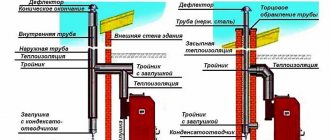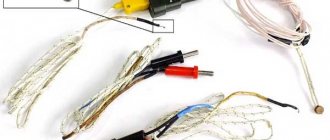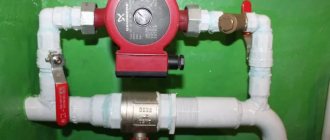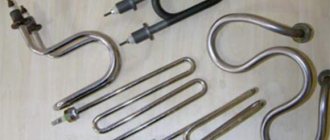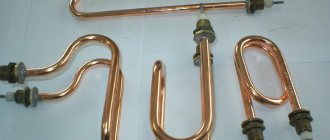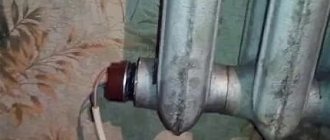One of the indispensable conditions for a comfortable life in a modern home is the presence of autonomous heating. Today, the most economical, efficient and safe heating systems are those operating on natural gas. We will analyze the principle of operation, purpose and structure of a gas boiler, what types of units exist and what are their features, as well as what are the main stages of installation technology and what are the specifics of operation and maintenance of gas boiler equipment in a private home.
Cross-sectional view of a double-circuit natural gas boiler Source prokommunikacii.ru
Operating principle, purpose
The operating principle of a gas boiler is quite simple, understandable and boils down to the following algorithm:
- An unheated coolant (water or special liquid) is supplied from the pipeline to the heat exchange circuit using a circulation pump.
- At the same time, the valve opens and gas fuel is supplied to the burner and its subsequent automatic ignition.
- In accordance with the timer settings and temperature sensor readings, an open flame heats the coolant inside the heat exchanger.
- Depending on the intensity of combustion and throughput, passing through the thermal circuit, the coolant, heated to the desired temperature, enters the heat pipe of the heating system and further into the radiators.
- When the system reaches a predetermined heating level, the flame goes out, and then, when cooling, it lights up again, etc. - depending on the settings of the external thermostat.
Schematic representation of the operation of a gas boiler Source otoplenie-gid.ru
If the gas unit is intended not only for heating, but also for hot water supply, it includes a second heat exchange circuit. In this case, the boiler is called a double-circuit boiler. At the same time, the additional heat exchanger, which is responsible for supplying hot water to the mixer, differs from the primary one in higher heating rates and water flow throughput.
Note! Some boiler models do not have separate circuits for heating and hot water. Therefore, they can only work in one mode. For example, when you open a tap in the system, the flow sensor is triggered - the heat exchanger begins to work to supply hot water supply. As soon as the water intake stops, it switches to heating mode.
Connection diagram of the heating system and boiler to a gas boiler Source kotlobzor.ru
See also: Catalog of companies that specialize in autonomous gasification of country houses and related work
How to save money when using a gas boiler?
The following measures can achieve additional fuel savings:
- high-quality installation of a gas boiler;
- open the windows completely for a short time, while closing the thermostatic valves;
- do not overheat the room, try to maintain the room temperature at 20 °C;
- When darkness falls, lower the blinds on the windows;
- adjust the thermostatic valves correctly;
- do not obstruct radiators and thermostatic valves;
- use the control capabilities of your boiler;
- turn on the DHW circulation pump only during use;
- control hot water consumption;
- Carry out regular maintenance: boiler cleaning and minor repairs.
Did the article help you? Ask your questions in the comments, our experts will definitely answer them.
Device, main components
A standard gas fuel heating boiler includes the following main operating units:
- Burner.
Carries out gas combustion and uniform distribution of the generated heat to the heat exchange circuit. It can be conventionally atmospheric or turbocharged - equipped with forced exhaust of combustion products.
- Heat exchanger.
It is a box with a curved tube located inside through which water passes for heating. Divided into single- and double-circuit. Made from copper, steel and cast iron.
- Circulation pump.
Provides constant water pressure in the pipeline for its optimal distribution throughout the system.
- Expansion tank.
Prevents emergency expansion of water and its vapors inside the system.
- Smoke exhaust.
Carries out the removal of combustion products to the outside. It can be conventional - atmospheric, as well as turbocharged - with a fan for forced exhaust of gases to the street.
- Control block.
Provides configuration of system operating parameters. Connects wires, sensors, sensors, electrical circuits.
Gas boiler control module Source stroy-podskazka.ru
- Sensors for automatic control of safety parameters.
Gas automation for boilers monitors the stability of operating parameters and the safety of the system. Prevents the development of an emergency situation for various reasons - overheating, traction shutdown, loss of flame in the burner, etc.
Advice! A standard double-circuit boiler produces up to 8 liters of domestic hot water per minute. If higher consumption is required, it is better to install a single-circuit model combined with a storage water heater. The volume of household boilers varies widely - from 50 to 300 liters. This is quite enough for the everyday needs of a private home.
Boiler powered by a gas boiler Source domkotlov.by
Protection system
Almost all models of modern gas boilers have a highly effective multi-level protection system. First of all, in the event of a gas supply interruption, the solenoid valve, which is responsible for the flow of fuel into the boiler, automatically closes. However, a significant drawback is that the valve does not open automatically when the gas supply is restored. In this case, the boiler must be restarted manually. If there is a power outage, then after it is restored the system starts up on its own.
Modern models have a long range of protective functions. One of the most important is to protect the system from freezing.
That is, the temperature of the coolant is constantly monitored by special sensors. And if it drops to a critical temperature, the system independently starts the boiler to warm up the coolant. Another extremely important and useful function is that to ensure high-quality performance, the system automatically starts the circulation pump once every certain period of time and “drives” the coolant. Thus, all elements are constantly maintained in working order.
If a malfunction occurs in the system, information about this will immediately be displayed on a special screen located on the control unit. Having discovered a malfunction and calling a service center specialist, you should definitely tell him the error code that appears on the display. Thus, the technician will arrive knowing in advance about the breakdown - and will be able to restore the system to functionality in the shortest possible time.
Gas boilers are quite economical - special equipment allows you to reduce not only fuel consumption, but also the calculation of a gas heating boiler, the energy consumption consumed by the system, and the efficiency of a gas heating boiler is acceptable.
Varieties
The functionality of household gas boiler equipment largely depends on the type of its main parts. There are several types of classification - according to the following criteria:
- Installation method.
They are divided into wall and floor. The former are small in size and have no more than average power. They take up little space and are designed for small spaces. The latter are more productive and are designed for heating spacious houses. For them, you need to equip a reliable boiler room in accordance with all building codes.
- Type of chimney and combustion chamber.
There are atmospheric and turbocharged ones. In the first case, fuel combustion waste is removed by natural draft, and oxygen is taken into the open-type chamber from the room itself, in the second - by a forced built-in fan, while the flow of oxygen into the closed-type chamber is carried out from the outside through an air duct.
- Number of heat exchangers.
Boilers with one circuit provide heating + a boiler, while those with two circuits provide hot water in addition to heating.
Piping of a 2-circuit gas unit Source szgaz.ru
- Ignition type.
In one version, the flame is ignited manually using a built-in piezoelectric element, in the other, special automation for heating boilers works. At the same time, it allows the boiler to operate without human control.
- Heat removal scheme.
Convection units transfer the heat of the fire directly to the coolant. More advanced condensation models additionally use the energy of water vapor. For this purpose, their design includes a special steam heat exchanger. The efficiency of such installations is significantly higher.
Helpful information! The heat exchange circuit made of cast iron is considered the most durable. However, during transportation and installation, one must take into account its large mass and fragility.
Cast iron heat exchanger for a gas boiler Source gradusplus.com
Chimney design
The chimney structure of a gas boiler is extremely important for the operation of the boiler, since it is thanks to it that combustion products are removed from the apparatus. True, it is a tube, and there are no special devices in it. However, they come in different types:
- Metal. They are sandwich panels made of lines of different diameters, made of stainless steel. The voids between them are usually filled with a basalt thermal insulation layer. They are highly reliable. They are multi-layered and have high heat-insulating properties. But they are assembled from a large number of parts, which is not entirely convenient.
- Ceramic. Simpler, but no less durable models. They even resist the effects of chemical substances. They are ceramic pipes wrapped in mineral wool. However, they require additional installation of condenser collectors.
- Coaxial chimney. Easy to use and looks great. Does not require installation of any additional devices. Condensation does not accumulate, which is also its advantage. And it is something like a pipe-within-a-pipe design. Can be used for closed type boilers (those that take air from the street. Open systems take air from the house). That is, air enters the boiler through the outer pipe, and exits through the inner pipe, being exhausted.
Coaxial chimney
Previously, a brick chimney was quite popular. But they are quite difficult to install, and they are quite bulky.
Installation stages
Installation of a wall-mounted gas boiler is carried out by specialists using the following technology:
- Preparing the room for placing the unit in accordance with regulatory requirements.
- Creation of a ventilation system.
- Installation of fasteners and brackets.
- Installation of the unit.
- Supply and connection of heating system pipes.
- Connecting cold water supply.
- Connecting gas boiler equipment to a gas source.
- Installation of wiring, connection of electrical appliances and automation.
- Installation of a chimney.
- Checking, preparing and test running the boiler.
Important! In the room where the gas boiler is installed, safety regulations must be strictly observed. Wall decoration is allowed only from non-combustible materials. In addition, the presence of an air gas sensor is a mandatory condition for operating the unit.
Heat exchanger
The durability of a heat exchanger depends on its material. Basically, users have to choose from two options:
Cast iron
The cast iron heat exchanger has thick walls, so it is durable and does not burn out.
In addition, it is little susceptible to corrosion.
Accordingly, this option is the most durable - it lasts about 25 years.
There are two disadvantages:
- fragility, and it can burst not only with a strong impact, but also with a sharp change in temperature;
- heavy weight.
The latter circumstance does not allow the use of cast iron heat exchangers in wall-mounted boilers.
Steel
A steel heat exchanger burns out relatively quickly (it has thin walls) and is highly susceptible to corrosion. In addition, it has weak points in the form of welds. As a result, the service life is only 15 years. But it is cheap, flexible and weighs little.
More durable are heat exchangers made of stainless, heat-resistant steel, which are installed in premium models.
Those buyers who cannot yet afford such a boiler can be advised to pay attention to steel heat exchangers with anti-corrosion protection in the form of a copper coating on the inside and special heat-resistant paint on the outside.
Features of operation and maintenance
After the installation of wall-mounted boilers or their floor-standing analogues is completed, the period of operational maintenance begins. To avoid breakdowns and emergency situations, equipment must be inspected at certain intervals. In addition to the gas unit itself, the heating system pipelines require no less attention.
Often the cause of an accident is blockage of the line by salt deposits accumulated on the inner surface of the pipes. This problem is especially acute when using hard water in the system. This can be solved by periodically carrying out preventive cleaning - by pumping special reagents into the pipeline.
Recommendation! Smart automatic control systems can significantly extend the operation of a gas unit and increase safety. Modern devices are equipped with sensors for gas pressure, flame intensity, chimney draft, heating and emergency control of the primary circuit, water pressure, safety valve, and hot water leakage. In the event of an emergency, the boiler will be automatically turned off, and the owner will be notified even at a distance - via SMS or the Internet.
Circulation pump operation
What the performance indicators of the circulation pump will be depends, first of all, on the power at which the boiler operates, and this device does not have much influence on the operation of the entire system. It is very important that the pipes through which the coolant circulates are made of high-quality material, for example, steel or good plastic.
Briefly about the main thing
The design of a natural gas boiler is based on the following working units included in its design:
- Flame former.
- Heat exchange circuit.
- Pump.
- Expansion tank.
- Chimney.
- Control module.
- Automation.
A gas boiler operates on the principle of burning natural gas in a burner and transferring the released energy to the coolant through a heat exchanger. The units differ in the method of installation, smoke exhaust and combustion chamber, number of heat exchange circuits, type of ignition and heat removal scheme. Installation of equipment is carried out by specialists strictly according to technology. Regular inspection is required during operation.
Using non-freezing liquid as a coolant
Antifreeze
If you plan to use antifreeze liquid (ethylene glycol or propylene glycol) as a coolant, then you should find out whether this is allowed by the manufacturer.
In the event of a breakdown, you may be denied warranty repairs. My opinion here is that antifreeze can only be a necessary measure.
For example, at the dacha, where you don’t want to drain the system every time in the fall. In other cases, the best choice is prepared water.
The most common type of single-circuit models
The vast majority of gas boilers, regardless of the number of circuits, are wall-mounted - that is, they are designed for installation on a wall, which must be load-bearing and durable. The wall-mounted installation method implies small dimensions and weight of the boiler, which acts as an additional advantage for users when choosing, since they take up little space and do not require the organization of a special room for the boiler room.
Such installations can be used both in suburban and urban environments. For example, this type of boiler device is often installed today in new urban residential complexes to provide an autonomous heating and hot water system.
Differences between devices according to ignition method
According to the method of ignition of gas fuel, single-circuit types of boiler units are divided into:
- electro addicts
- piezo electric
Boiler devices, which are electrically dependent, “produce” a spark to ignite gas fuel using electrodes. The spark created between these electrodes provokes the burner to turn on. This ignition method is considered the safest. Devices of the second type are equipped with a piezoelectric element, which acts as an igniter for igniting the burner.
